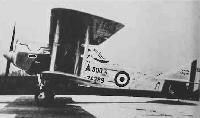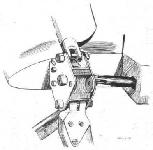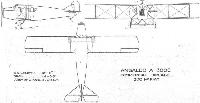Ansaldo А.300
Фирма "Ansaldo" в 1918 году приступила к проектированию боевого аэроплана смешанной конструкции, используя опыт создания бипланов SVA и поставив целью создать двухместный разведчик-бомбардировщик, по своим летным характеристикам значительно превосходящий самолеты SVA. Результатом стал Ansaldo А.300, который выполнил первый полет в начале 1919 года. Самолет показал себя маневренным и легким в пилотировании. Летные испытания шли быстро, уже вскоре после их начала А.300 был готов к демонстрационному туру по странам Европы.
Своими высокими характеристиками А.300 привлек внимание ряда стран после окончания Первой мировой войны. Первый заказ на небольшую партию самолетов А.300/2 поступил от Польши. В конце 1920 года появился трехместный А.300/3; самолеты данной модели экспортировались в Испанию, Бельгию и Польшу.
Между тем, руководство фирмы "Ansaldo" не полностью удовлетворяло их детище, и она продолжала его совершенствовать, создав А.300/4, мотор которого охлаждался двумя радиаторами Ламблена. В 1924 году Польша закупила примерно 30 самолетов А.300/4, которые показали себя более надежными, чем 70 А.300/2, построенных в Польше по лицензии в 1921-1924 годах. Самолеты польской постройки не отличались прочностью.
Итальянские ВВС также заказали крупную партию А.300/4, закупив в конечном итоге почти 700 таких самолетов, которые применялись в длительной колониальной войне в Ливии.
К поздним вариантам самолета относятся А.300/5 с двигателем Lorraine, пассажирские А.300C и А.300T.
Более глубокой модернизацией стал А.300/6, который конструктивно существенно отличался от А.300/4.
На прототипе А.400 стоял двигатель Lorraine, конструкция самолета была улучшена, но в серийное производство он не пошел.
ТАКТИКО-ТЕХНИЧЕСКИЕ ХАРАКТЕРИСТИКИ
Ansaldo А.300/4
Тип: двухместный разведчик
Силовая установка: поршневой двигатель жидкостного охлаждения Fiat А.12bis мощностью 230 л. с.
Характеристики: макс, скорость на уровне моря 200 км/ч; время набора высоты 5000 м - 33 мин 30 с; практический потолок 5500 м; продолжительность полета 3 ч 30 мин
Массы: пустого 1200 кг; максимальная взлетная масса 1700 кг
Размеры: размах крыла 11,24 м; длина 8,75 м; высота 2,97 м; площадь крыла 39,50 м2
Вооружение: два синхронных пулемета калибра 7,7 мм и один пулемет того же калибра на турели в задней кабине
Показать полностьюShow all
Flight, June 1921
THE ANSALDO A-300 C COMMERCIAL BIPLANE
WE give herewith some brief particulars, together with general arrangement drawings and illustrations, of a commercial “limousine" biplane recently produced by the well-known Italian firm S.I.A. Gio. Ansaldo and Co. of Rome. One of these machines was taken over and flown in America, and last May flew from Mineola, Long Island (N.Y.), to Chicago - a distance of over 700 miles - in 7 1/2 hours' flying time, with three passengers and 500 lbs. of express matter.
The Ansaldo A-300 C was designed by the firm's engineer, Sig. Brezzi, specially for the transport of passengers, etc., and is essentially different in design from the war machines produced by this firm. Considering the useful load carried (1,600-1,700 lbs.), the power employed (300 h.p.) is by no means excessive, and its aerodynamic properties and general characteristics are such that it has a good all-round performance, especially for commercial transport work, without any sacrifice of safety or comfort of passengers. It is stated that this machine is exceptionally nice to fly.
Two alternative methods of construction are employed for the fuselage - one with tubular steel framework, the other, wood. In the metal type the front portion of the fuselage, from nose to leading edge of the main planes, containing the engine - a 300 h.p. Fiat A-12-bis - is made detachable, which greatly facilitates the changing of engines and transport. In other respects both types have the same general characteristics. The fuselage is of deep rectangular section, extending from top to bottom planes, and tapering sharply to a vertical knife-edge at the rear. Aft of the engine compartment is the pilot's and mechanic's cabin, which is totally enclosed and is provided with front and side windows, and a door at the side. At the rear of this cabin is another for the passengers, extending beyond the trailing edge of the main planes. The passengers' cabin is large and comfortable - measuring, roughly, 5 ft. long, 6 ft. high, by 4 ft. wide - and accommodates four passengers, who are seated in wicker armchairs. Access to the cabin is by way of a large door in the side of the fuselage, and a good view is obtained from three windows on each side. The rear part of the fuselage, aft of the cabin, is detachable, and is covered with fabric; the cabin portion is covered with ply-wood, and the engine section with sheet aluminium. The radiator is mounted in the nose of the fuselage, and is provided with a means for varying the exposed area of cooling surface.
The main planes are without stagger or sweepback, and upper and lower surfaces are of equal span and chord, and are identical, thus facilitating replacement. They are in four sections, attached to small wing roots growing out of the fuselage, which are braced to the latter by faired tubular steel struts. There are two pairs of interplane struts each side, consisting of round steel tubes faired to a streamline section, and external bracing is by streamline-wire. Unbalanced ailerons are fitted to all four wings. The tail consists of a triangular horizontal stabilising surface, divided unbalanced elevators, a vertical fin and a balanced rudder. The angle of incidence of the tail plane can be varied, during flight, from the pilot's cockpit.
The landing chassis is exceptionally wide - nearly 10 ft. - and consists of two V's (metal) attached to the lower centre section connected by a wing-form axle, braced to the fuselage at the centre by inverted V struts.
The factor of safety of the wings is 8 1/2, and over 9 for the fuselage. Petrol is delivered from the main tank to a service tank in the roof of the pilot's cabin, thence to the engine.
The main characteristics of the Ansaldo A-300 C are :-
Span 44 ft. 9 1/2 ins.
Chord 6 ft. 6 ins.
Gap 5 ft. 6 ins.
Overall length 31 ft. 8 ins.
Overall height 10 ft. 9 1/2 ins.
Area of main planes 473.4 sq. ft.
Weight (total) 4,I87 lbs.
Weight (empty) 2,534 lbs.
Useful load 1,653 lbs.
Loading/h.p. 14 lbs.
Loading/sq. ft. 8.85 lbs.
Speed range 43-120 m.p.h.
Cruising speed 100 m.p.h.
Endurance 5 hrs.
Ceiling (full load) 16,000 ft.
Climb (15 mts.) 7,000 ft.
Показать полностьюShow all
Flight, November 1921
The Paris Aero Show – 1921
ANSALDO AERONAUTIQUE
366, Corso Francia, Turin, & 21, Rue Demours, Paris
This Italian representative is showing a single-engined cabin machine which is announced to be strictly en serie. The machine arrived a couple of days late, and a side view of it could not, therefore, be included in our issue of last week. Of the type "A.300T," this machine has a Fiat engine of 300 h.p. mounted in the nose, with radiator in front. The fuselage is of rectangular section, and covered with ply-wood. The cabin is well appointed, and has room for six passengers, who are seated in wickerwork chairs. A feature of the Ansaldo cabin is that it is provided with two small front windows, which give a reasonably good view, at any rate as regards the front passengers. These windows are provided by sweeping - in the fuselage covering in front of the cabin, which is made possible by the smaller width and depth required for the engine. In a way this feature of the cabin may seem of small importance, but, as a matter of fact, it adds greatly to one's comfort and peace of mind to be able to look out in the direction in which the machine is going.
The pilot is placed aft of the cabin, and there is a circular window in the wall, by means of which communication between pilot and passengers is made possible, for instance by handing messages backwards and forwards.
A feature of the Ansaldo "A.300T," is the very wide wheel track. To attain this it has been necessary to attach the undercarriage struts to the lower plane, and hence a somewhat unusual strut arrangement has been adopted. Short wing roots are attached to the fuselage, and to these the planes are secured. From these points of attachment, struts run to the sides of the fuselage, approximately half-way up the sides. Thus, the short wing roots are braced permanently to the body, and the undercarriage Vees are secured to the ends of the roots. A further series of struts triangulate the undercarriage structure, which looks tremendously strong, but would appear to offer quite a lot of resistance. With a power expenditure of 50 h.p. per passenger at full power, and a good performance, the Ansaldo should be a very useful machine for routes on which a large number of passengers is not to be counted upon.
Показать полностьюShow all















